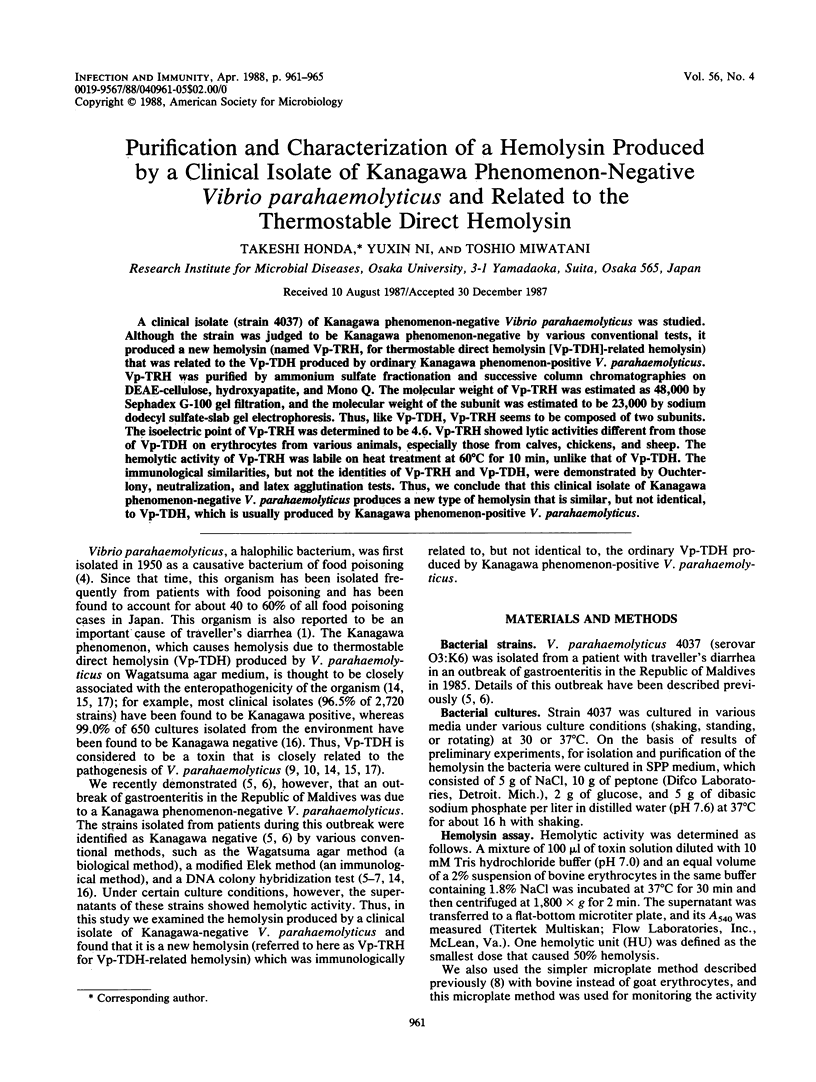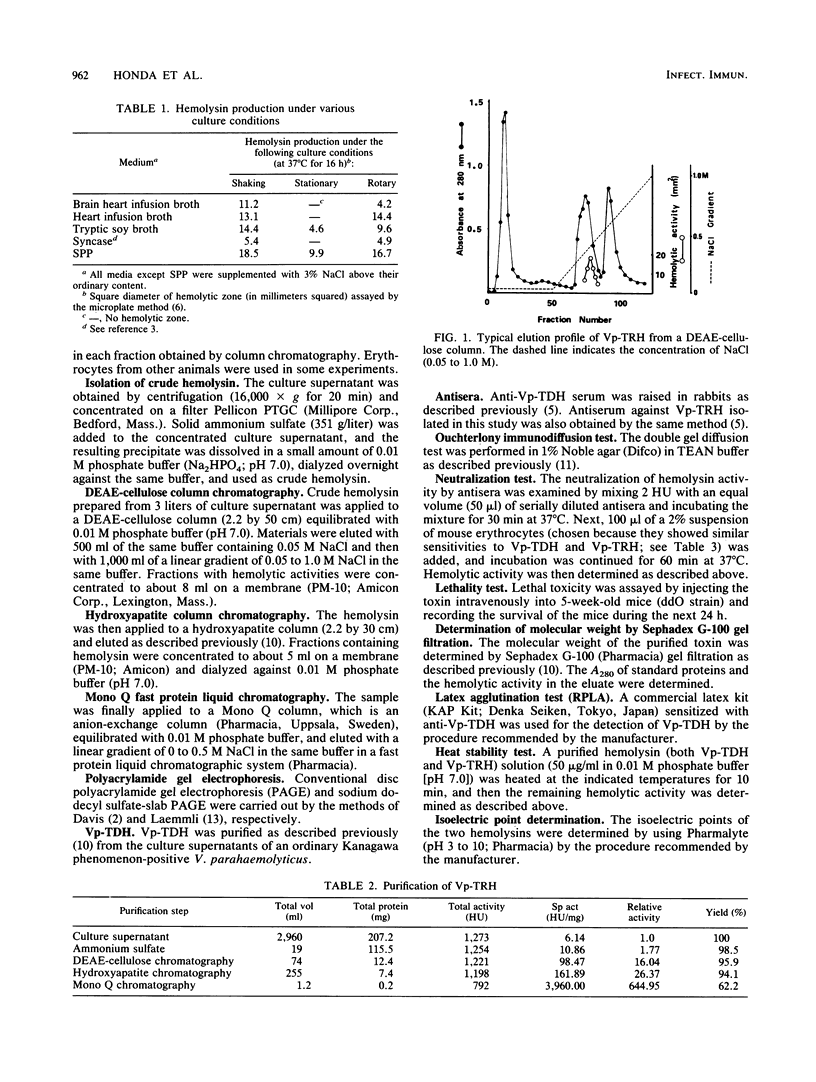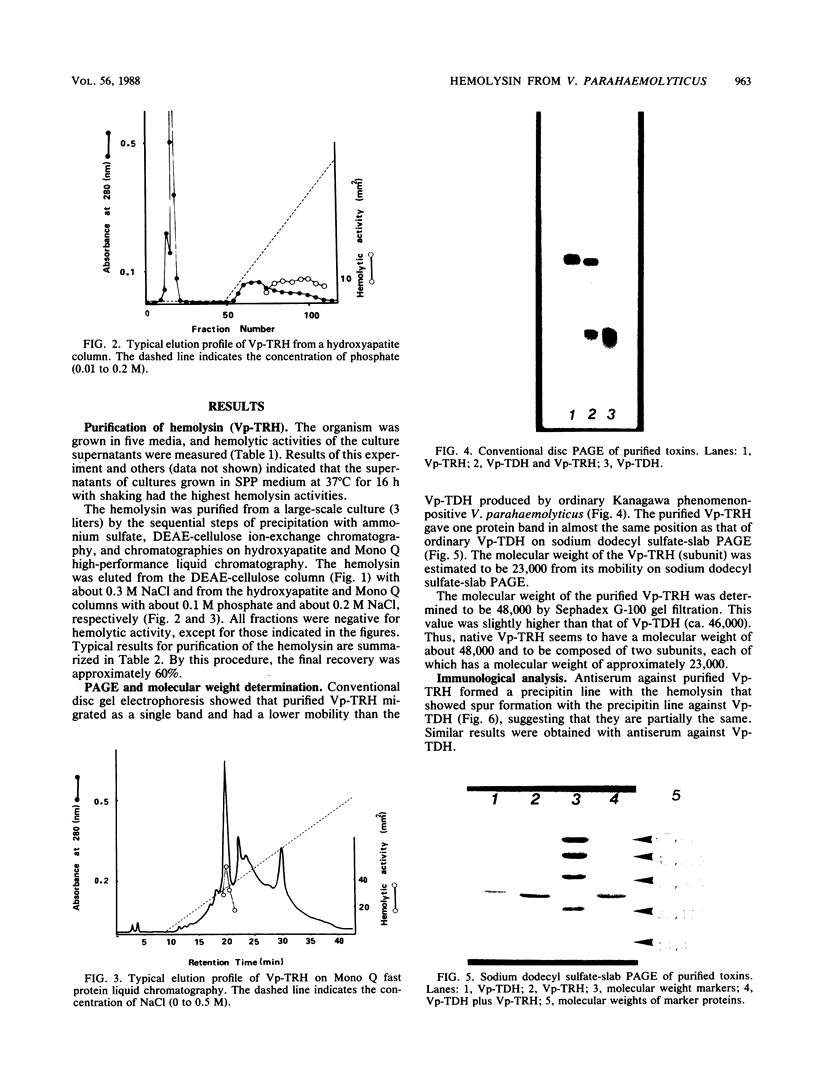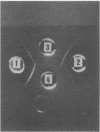Abstract
A clinical isolate (strain 4037) of Kanagawa phenomenon-negative Vibrio parahaemolyticus was studied. Although the strain was judged to be Kanagawa phenomenon-negative by various conventional tests, it produced a new hemolysin (named Vp-TRH, for thermostable direct hemolysin [Vp-TDH]-related hemolysin) that was related to the Vp-TDH produced by ordinary Kanagawa phenomenon-positive V. parahaemolyticus. Vp-TRH was purified by ammonium sulfate fractionation and successive column chromatographies on DEAE-cellulose, hydroxyapatite, and Mono Q. The molecular weight of Vp-TRH was estimated as 48,000 by Sephadex G-100 gel filtration, and the molecular weight of the subunit was estimated to be 23,000 by sodium dodecyl sulfate-slab gel electrophoresis. Thus, like Vp-TDH, Vp-TRH seems to be composed of two subunits. The isoelectric point of Vp-TRH was determined to be 4.6. Vp-TRH showed lytic activities different from those of Vp-TDH on erythrocytes from various animals, especially those from calves, chickens, and sheep. The hemolytic activity of Vp-TRH was labile on heat treatment at 60 degrees C for 10 min, unlike that of Vp-TDH. The immunological similarities, but not the identities of Vp-TRH and Vp-TDH, were demonstrated by Ouchterlony, neutralization, and latex agglutination tests. Thus, we conclude that this clinical isolate of Kanagawa phenomenon-negative V. parahaemolyticus produces a new type of hemolysin that is similar, but not identical, to Vp-TDH, which is usually produced by Kanagawa phenomenon-positive V. parahaemolyticus.
Full text
PDF




Images in this article
Selected References
These references are in PubMed. This may not be the complete list of references from this article.
- Abe H., Ichiki S., Hashimoto S., Nakano H., Sato K., Kanda T., Yanai Y., Tsukamoto T., Kinoshita Y., Arita M. Isolation and characterization of enterotoxigenic Escherichia coli from patients with traveller's diarrhoea in Osaka. J Diarrhoeal Dis Res. 1984 Jun;2(2):83–87. [PubMed] [Google Scholar]
- DAVIS B. J. DISC ELECTROPHORESIS. II. METHOD AND APPLICATION TO HUMAN SERUM PROTEINS. Ann N Y Acad Sci. 1964 Dec 28;121:404–427. doi: 10.1111/j.1749-6632.1964.tb14213.x. [DOI] [PubMed] [Google Scholar]
- Finkelstein R. A., Atthasampunna P., Chulasamaya M., Charunmethee P. Pathogenesis of experimental cholera: biologic ativities of purified procholeragen A. J Immunol. 1966 Mar;96(3):440–449. [PubMed] [Google Scholar]
- Honda S., Goto I., Minematsu I., Ikeda N., Asano N., Ishibashi M., Kinoshita Y., Nishibuchi M., Ohnda T., Miwatani T. [Vibrio parahaemolyticus infectious disease caused by Kanagawa phenomenon-negative O3:K6 originated from Maldives]. Kansenshogaku Zasshi. 1987 Sep;61(9):1070–1078. doi: 10.11150/kansenshogakuzasshi1970.61.1070. [DOI] [PubMed] [Google Scholar]
- Honda T., Chearskul S., Takeda Y., Miwatani T. Immunological methods for detection of Kanagawa phenomenon of Vibrio parahaemolyticus. J Clin Microbiol. 1980 Jun;11(6):600–603. doi: 10.1128/jcm.11.6.600-603.1980. [DOI] [PMC free article] [PubMed] [Google Scholar]
- Honda T., Finkelstein R. A. Purification and characterization of a hemolysin produced by Vibrio cholerae biotype El Tor: another toxic substance produced by cholera vibrios. Infect Immun. 1979 Dec;26(3):1020–1027. doi: 10.1128/iai.26.3.1020-1027.1979. [DOI] [PMC free article] [PubMed] [Google Scholar]
- Honda T., Goshima K., Takeda Y., Sugino Y., Miwatani T. Demonstration of the cardiotoxicity of the thermostable direct hemolysin (lethal toxin) produced by Vibrio parahaemolyticus. Infect Immun. 1976 Jan;13(1):163–171. doi: 10.1128/iai.13.1.163-171.1976. [DOI] [PMC free article] [PubMed] [Google Scholar]
- Honda T., Taga S., Takeda T., Hasibuan M. A., Takeda Y., Miwatani T. Identification of lethal toxin with the thermostable direct hemolysin produced by Vibrio parahaemolyticus, and some physicochemical properties of the purified toxin. Infect Immun. 1976 Jan;13(1):133–139. doi: 10.1128/iai.13.1.133-139.1976. [DOI] [PMC free article] [PubMed] [Google Scholar]
- Honda T., Tsuji T., Takeda Y., Miwatani T. Immunological nonidentity of heat-labile enterotoxins from human and porcine enterotoxigenic Escherichia coli. Infect Immun. 1981 Nov;34(2):337–340. doi: 10.1128/iai.34.2.337-340.1981. [DOI] [PMC free article] [PubMed] [Google Scholar]
- Honda T., Yoh M., Kongmuang U., Miwatani T. Enzyme-linked immunosorbent assays for detection of thermostable direct hemolysin of Vibrio parahaemolyticus. J Clin Microbiol. 1985 Sep;22(3):383–386. doi: 10.1128/jcm.22.3.383-386.1985. [DOI] [PMC free article] [PubMed] [Google Scholar]
- Hondo S., Goto I., Minematsu I., Ikeda N., Asano N., Ishibashi M., Kinoshita Y., Nishibuchi N., Honda T., Miwatani T. Gastroenteritis due to Kanagawa negative Vibrio parahaemolyticus. Lancet. 1987 Feb 7;1(8528):331–332. doi: 10.1016/s0140-6736(87)92062-9. [DOI] [PubMed] [Google Scholar]
- Laemmli U. K. Cleavage of structural proteins during the assembly of the head of bacteriophage T4. Nature. 1970 Aug 15;227(5259):680–685. doi: 10.1038/227680a0. [DOI] [PubMed] [Google Scholar]
- Miyamoto Y., Kato T., Obara Y., Akiyama S., Takizawa K., Yamai S. In vitro hemolytic characteristic of Vibrio parahaemolyticus: its close correlation with human pathogenicity. J Bacteriol. 1969 Nov;100(2):1147–1149. doi: 10.1128/jb.100.2.1147-1149.1969. [DOI] [PMC free article] [PubMed] [Google Scholar]
- Miyamoto Y., Obara Y., Nikkawa T., Yamai S., Kato T., Yamada Y., Ohashi M. Simplified purification and biophysicochemical characteristics of Kanagawa phenomenon-associated hemolysin of Vibrio parahaemolyticus. Infect Immun. 1980 May;28(2):567–576. doi: 10.1128/iai.28.2.567-576.1980. [DOI] [PMC free article] [PubMed] [Google Scholar]
- Nishibuchi M., Ishibashi M., Takeda Y., Kaper J. B. Detection of the thermostable direct hemolysin gene and related DNA sequences in Vibrio parahaemolyticus and other vibrio species by the DNA colony hybridization test. Infect Immun. 1985 Sep;49(3):481–486. doi: 10.1128/iai.49.3.481-486.1985. [DOI] [PMC free article] [PubMed] [Google Scholar]
- Sakazaki R., Tamura K., Kato T., Obara Y., Yamai S. Studies on the enteropathogenic, facultatively halophilic bacterium, Vibrio parahaemolyticus. 3. Enteropathogenicity. Jpn J Med Sci Biol. 1968 Oct;21(5):325–331. doi: 10.7883/yoken1952.21.325. [DOI] [PubMed] [Google Scholar]






